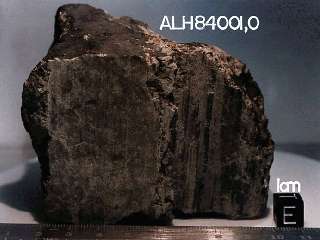pop up description layer
HOME
Cryptozoology UFO Mysteries Aviation Space & Time Dinosaurs Geology Archaeology Exploration 7 Wonders Surprising Science Troubled History Library Laboratory Attic Theater Store Index/Site Map Cyclorama
Search the Site: |
|
Life on Mars?
A pebble, with a unique history, may contain the first evidence of life beyond the plant Earth. Sample ALH84001 started its existence when it crystallized out of hot magma on the planet Mars some 4.5 billion years ago. Half a billion years later it became a space traveler when an asteroid or comet struck the planet and sent chunks of Martian crust flying into space. Caught by the gravity of the Sun it drifted toward the center of the solar system until 13,000 years ago when it collided with Earth and landed in Antarctica. In 1984 it was picked up by scientists who identified it's place of origin by comparing bubbles trapped in the rock with the known mixture of gases on Mars. What makes this little rock so interesting isn't just its interplanetary wanderings. It's the tiny tubular shapes found inside. They resemble fossilized bacteria (below-left, NASA). Concentrated around the shapes are three different chemical compounds that may well have been the by-product of the ancient microbe activity. NASA scientists concluded that a "reasonable interpretation" of the facts was that there once was, and perhaps still is, life on Mars. Other scientists disagree pointing out that all the chemicals could have been formed by other natural processes. They also note the shapes are a hundred times smaller than the smallest known Earth bacteria. Supporters of the life theory claim that with all the compounds concentrated in such a small space, other explanations, besides life, are unlikely. As for the size they point to the work of Robert Folk, of the University of Texas, who claims to have found almost identically small Earth microbes living in travertein and limestone rock. Folk's tiny bacteria have yet to be fully accepted within the scientific community, though. Until scientists can figure out how to slice the shapes open, not an easy task because they are so small, and find something inside that resembles the structure of a cell, the question, of life on Mars, will be open for debate.
The rock was originally located deep under the Martian surface and if it turns out it truly bears microfossils then it seems a real possibility that life may, even now, thrive underground on Mars. Just a few years ago scientists might have laughed at the idea living creatures could subsist without getting energy from the sun, but recently bacteria has been found living almost a mile below the surface of the Earth surviving on nothing but water and hydrogen from the surrounding basalt rock. Similar underground conditions could exist on Mars. In Romania a whole ecosystem, including spiders, scorpions, leeches and millipedes, has been found in a cave that was cut off from the surface of the Earth 5.5 million years ago. The entire thing was fueled by bacteria that eats the surrounding rock. If the same thing has happened on Mars we may find that more complex creatures than just bacteria may thrive on that planet, if we can just look below the surface. Copyright Lee Krystek 1996. All Rights Reserved. |
|
Related Links |
|
|





